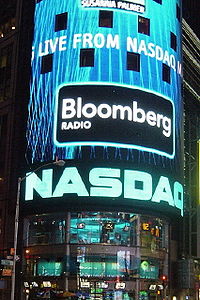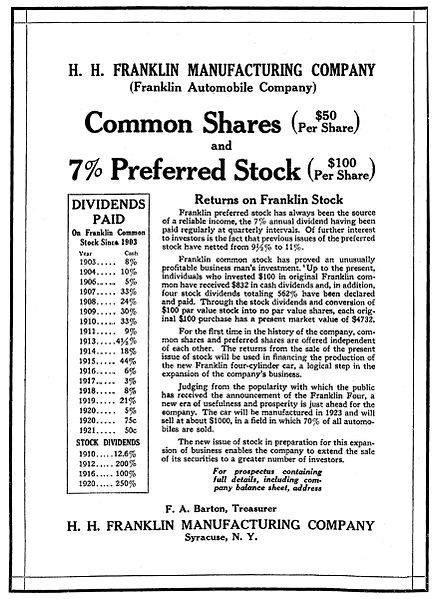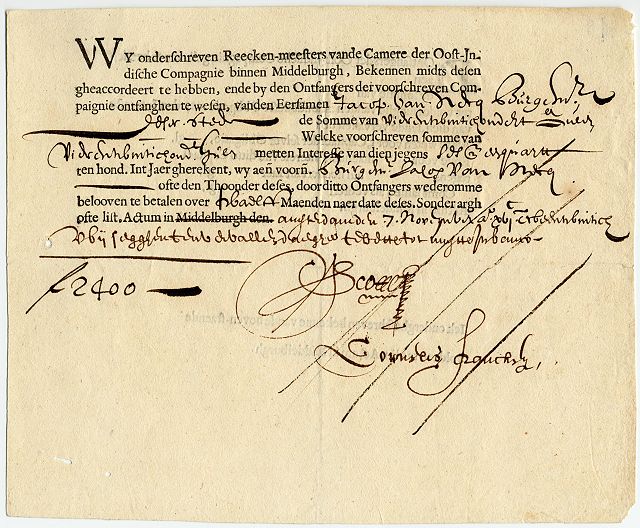Claim to Income
In the cases of bankruptcy and dividend distribution, preferred stock shareholders will receive assets before common stock shareholders.
Learning Objectives
Describe the rights preferred stock has to a company’s income
Key Takeaways
Key Points
- Common stock and preferred stock are both forms of equity ownership but carry different rights and claims to income.
- Preferred stock shareholders will have claim to assets over common stock shareholders in the case of company liquidation.
- Preferred stock also has first right to dividends.
Key Terms
- Preferred Stock: Preferred stock is an equity security that has the properties of both an equity and debt instrument and is higher ranking than common stock.
- Common stock: Common stock is a form of equity and type of security. Common stock shareholders are at the bottom of the line when it comes to dividends and receiving compensation in the case of bankruptcy.
Preferred and common stock have varying claims to income which will change from one equity issuer to another. In general, preferred stock will be given some preference in assets to common assets in the case of company liquidation, but both will fall behind bondholders when asset distribution takes place. In the event of bankruptcy, common stock investors receive any remaining funds after bondholders, creditors (including employees), and preferred stock holders are paid. As such, these investors often receive nothing after a bankruptcy. Preferred stock also has the first right to receive dividends. In general, common stock shareholders will not receive dividends until it is paid out to preferred shareholders. Access to dividends and other rights vary from firm to firm.

Preferred stock may or may not have a fixed liquidation value (or par value) associated with it. This represents the amount of capital that was contributed to the corporation when the shares were first issued. Preferred stock has a claim on liquidation proceeds of a stock corporation equal to its par (or liquidation) value, unless otherwise negotiated. This claim is senior to that of common stock, which has only a residual claim.
Both types of stock can have a claim to income in the form of capital appreciation as well. As company value increases based on market determinants, the value of equity held in this company also will increase. This translates to a return on investment to shareholders. This will be different to common stock shareholders and preferred stock shareholders because of the different prices and rewards based on holding these different kinds of shares. In turn, should market forces decrease, the value of equity held will decrease as well, reflecting a loss on investment and, therefore, a decrease on the value of any claims to income for shareholders.
Voting Right
Common stock generally carries voting rights, while preferred stock does not; however, this will vary from company to company.
Learning Objectives
Summarize the voting rights associated with common and preferred stock
Key Takeaways
Key Points
- Common stock shareholders can generally vote on issues, such as members of the board of directors, stock splits, and the establishment of corporate objectives and policy.
- While having superior rights to dividends and assets over common stock, generally preferred stock does not carry voting rights.
- Many of the voting rights of a shareholder can be exercised at annual general body meetings of companies. An annual general meeting is a meeting that official bodies, and associations involving the general public, are often required by law to hold.
Key Terms
- Common stock: Common stock is a form of equity and type of security. Common stock shareholders are at the bottom of the line when it comes to dividends and receiving compensation in the case of bankruptcy.
- Preferred Stock: Preferred stock is an equity security that has the properties of both an equity and debt instrument and is higher ranking than common stock.
- Voting rights: Rights which are generally associated with common stock shareholders in regards to business entity matters ( such as electing the board of directors or establishing corporate policy).
Voting Rights
Common stock can also be referred to as a “voting share. ” Common stock usually carries with it the right to vote on business entity matters, such as electing the board of directors, establishing corporate objectives and policy, and stock splits. However, common stock can be broken into voting and non-voting classes. While having superior rights to dividends and assets over common stock, generally preferred stock does not carry voting rights.
The matters that a stockholder gets to vote on vary from company to company. In many cases, the shareholder will be able to vote for members of a company board of directors and, in general, each share gets a vote as opposed to each shareholder. Therefore, a single investor who owns 300 shares will have more say in a voting matter than a single shareholder that owns 30.

Exercising Voting Rights
Many of the voting rights of a shareholder can be exercised at annual general body meetings of companies. An annual general meeting is a meeting that official bodies and associations involving the general public (including companies with shareholders) are often required by law (or the constitution, charter, by-laws, etc., governing the body) to hold. An AGM is held every year to elect the board of directors and inform their members of previous and future activities. It is an opportunity for the shareholders and partners to receive copies of the company’s accounts, as well as reviewing fiscal information for the past year and asking any questions regarding the directions the business will take in the future. Shareholders also have the option to mail their votes in if they cannot attend the shareholder meetings. In 2007, the Securities and Exchange Commission voted to require all public companies to make their annual meeting materials available online. Shareholders with the right to vote will have numerous options in how to make their voice heard with regards to voting matters should they choose to.
Purchasing New Shares
New shares can be purchased on exchanges and current shareholders will usually have preemptive rights to newly issued shares.
Learning Objectives
Discuss the process and implication of purchasing new shares by a shareholder that already holds shares in a company
Key Takeaways
Key Points
- New share purchase is an important indicator of current shareholder belief in the health of the company and long term prospects for growth.
- Current Shareholders will often have preemptive rights that give them the right to purchase newly issued company shares before they go on sale to the general public.
- New shares can be purchased on exchanges, which offer a platform for the financial marketplace.
Key Terms
- Stock Exchange: A form of exchange that provides services for stock brokers and traders to trade stocks, bonds and other securities.
- Preemption: The right of a shareholder to purchase newly issued shares of a business entity before they are available to the general public so as to protect individual ownership from dilution.

New share purchases are an important action by share shareholders, since it requires a further investment in a business entity and is a reflection of a shareholder’s decision to maintain an ownership position in a company, or a potential investor ‘s belief that purchasing equity in a company will be an investment that grows in value.
Current shareholders may have preemptive rights over new shares offered by the company. In practice, the most common form of preemption right is the right of existing shareholders to acquire new shares issued by a company in a rights issue, a usually but not always public offering. In this context, the preemptive right is also called “subscription right” or “subscription privilege. ” This is the right, but not the obligation, of existing shareholders to buy the new shares before they are offered to the public. In this way, existing shareholders can maintain their proportional ownership of the company, preventing stock dilution.
New shares may be purchased over the same exchange mechanisms that previous stock was acquired. A stock exchange is a form of exchange which provides services for stock brokers and traders to trade stocks, bonds, and other securities. Stock exchanges also provide facilities for issue and redemption of securities and other financial instruments, and capital events, including the payment of income and dividends. The initial offering of stocks and bonds to investors is by definition done in the primary market and subsequent trading is done in the secondary market. A stock exchange is often the most important component of a stock market. Supply and demand in stock markets are driven by various factors that, as in all free markets, affect the price of stocks.
Preferred Stock Rules and Rights
Preferred stock can include rights such as preemption, convertibility, callability, and dividend and liquidation preference.
Learning Objectives
List the rights that preferred stock generally has
Key Takeaways
Key Points
- Preferred stock generally does not carry voting rights, but this may vary from company to company.
- Preferred stock can gain cumulative dividends, convertibility to common stock, and callability.
- The rights that come with ownership of preferred stock are detailed in a “Certificate of Designation.”
Key Terms
- Preferred Stock: Preferred stock is an equity security that has the properties of both an equity and debt instrument and is higher ranking than common stock.
- liquidation: liquidation is the process by which a company (or part of a company) is brought to an end, and the assets and property of the company redistributed.
Preferred stock usually carries no voting rights, but may carry a dividend and may have priority over common stock in the payment of dividends and upon liquidation. Terms of the preferred stock are stated in a “Certificate of Designation. ”

Preferred stock is a special class of shares that may have any combination of features not possessed by common stock. The following features are usually associated with preferred stock: Preference in dividends preference in assets, in the event of liquidation, convertibility to common stock, callability, and at the option of the corporation. Some preferred shares have special voting rights to approve extraordinary events (such as the issuance of new shares or approval of the acquisition of a company) or to elect directors, but, once again, most preferred shares have no voting rights associated with them. Some preferred shares gain voting rights when the preferred dividends are in arrears for a substantial time.
Preferred stock may or may not have a fixed liquidation value (or par value ) associated with it. This represents the amount of capital which was contributed to the corporation when the shares were first issued. Preferred stock has a claim on liquidation proceeds of a stock corporation equal to its par (or liquidation) value, unless otherwise negotiated. This claim is senior to that of common stock, which has only a residual claim.Almost all preferred shares have a negotiated, fixed-dividend amount. The dividend is usually specified as a percentage of the par value, or as a fixed amount. Sometimes, dividends on preferred shares may be negotiated as floating; they may change according to a benchmark interest-rate index. Preferred stock may also have rights to cumulative dividends.
Provisions of Preferred Stock
Preferred shares have numerous rights which can be attached to them, such as cumulative dividends, convertibility, and participation.
Learning Objectives
Describe in detail the different types of provisions for preferred stock
Key Takeaways
Key Points
- If a preferred share has cumulative dividends, then it contains the provision that should a company fail to pay out dividends at any time at the stated rate, then the issuer will have to make up for it as time goes on.
- Convertible preferred stock can be exchanged for a predetermined number of company common stock shares.
- Often times companies will keep the right to call or buy back preferred shares at a predetermined price.
- Participating preferred issues offer holders the opportunity to receive extra dividends if the company achieves predetermined financial goals.
- Sometimes, dividends on preferred shares may be negotiated as floating; they may change according to a benchmark interest-rate index.
Key Terms
- Convertible preferred stock: Convertible preferred stock can be exchanged for a predetermined number of company common stock shares.
- Callable shares: Shares which can be bought back by the issuer at a predetermined price.
- Cumulative Dividends: Condition where owners of certain shares will receive accumulated dividends in the case a company cannot pay out dividends at the stated rate at the stated time.
Preferred stock may be entitled to numerous rights, depending on what is designated by the issuer. One of these rights may be the right to cumulative dividends. Preferred stock shareholders already have rights to dividends before common stock shareholders, but cumulative preferred shares contain the provision that should a company fail to pay out dividends at any time at the stated rate, then the issuer will have to make up for it as time goes on.

Convertible preferred stock can be exchanged for a predetermined number of company common stock shares. Generally, this can occur at the discretion of the investor, and he or she may pick any time to do so and, therefore, take advantage of fluctuations in the price of common stock. Once converted, the common stock cannot be converted back to preferred status.
Often times companies will keep the right to call or buy back preferred shares at a predetermined price. These shares are callable shares.
There is a class of preferred shares known as “participating preferred stock. ” These preferred issues offer holders the opportunity to receive extra dividends if the company achieves predetermined financial goals. Investors who purchased these stocks receive their regular dividend regardless of company performance (assuming the company does well enough to make its annual dividend payments). If the company achieves predetermined sales, earnings, or profitability goals, the investors receive an additional dividend.
Almost all preferred shares have a negotiated, fixed-dividend amount. The dividend is usually specified as a percentage of the par value, or as a fixed amount. Sometimes, dividends on preferred shares may be negotiated as floating; they may change according to a benchmark interest-rate index or floating rate. An example of this would be tying the dividend rate to LIBOR.
Comparing Common Stock, Preferred Stock, and Debt
Common stock, preferred stock, and debt are all securities that a company may offer; each of these securities carries different rights.
Learning Objectives
Differentiate between the rights of common shareholders, preferred shareholders, and bond holders
Key Takeaways
Key Points
- Common stock and preferred stock fall behind debt holders as creditors that would receive assets in the case of company liquidation.
- Common stock and preferred stock are both types of equity ownership. They receive rights of ownership in the company, such as voting and dividends.
- Debt holders often receive a bond for lending and while this does not give the ownership rights of being a stockholder, it does create a superior claim to a company’s assets in the case of liquidation.
Key Terms
- Common stock: Common stock is a form of corporate equity ownership, a type of security.
- bond: A bond is an instrument of indebtness of the bond issuers toward the bond holders.
- Preferred Stock: Preferred stock is an equity security that has the properties of both an equity and debt instrument and is higher ranking than common stock.
Equity
Common Stock and Preferred Stock are both methods of purchasing equity in a business entity.
Common stock generally carries voting rights along with it, while preferred shares generally do not.
Preferred shares act like a hybrid security, in between common stock and holding debt. Preferred stock can (depending on the issue) be converted to common stock and have access to accumulated dividends and multiple other rights. Preferred stock also has access to dividends and assets in the case of liquidation before common stock does.
However, both common and preferred stock fall behind debt holders when it comes to claims to assets of a business entity should bankruptcy occur. Common shareholders often do not receive any assets after bankruptcy as a result of this principle. However, common stock shareholders can theoretically use their votes to affect company decision making and direction in a way they believe will help the company avoid liquidation in the first place.
Debt
Debt can be “purchased” from a company in the form of a bond.

In finance, a bond is an instrument of indebtedness of the bond issuer to the holders. It is a debt security, under which the issuer owes the holders a debt and, depending on the terms of the bond, is obliged to pay them interest and/or to repay the principal at a later date, termed the maturity. Therefore, a bond is a form of loan or IOU: the holder of the bond is the lender (creditor), the issuer of the bond is the borrower (debtor), and the coupon is the interest. Bonds provide the borrower with external funds to finance long-term investments, or, in the case of government bonds, to finance current expenditure.
Bonds and stocks are both securities, but the major difference between the two is that (capital) stockholders have an equity stake in the company (i.e., they are owners), whereas, bondholders have a creditor stake in the company (i.e., they are lenders). Another difference is that bonds usually have a defined term, or maturity, after which the bond is redeemed, whereas stocks may be outstanding indefinitely.
Licenses and Attributions
CC licensed content, Shared previously
- Curation and Revision. Provided by: Boundless.com. License: CC BY-SA: Attribution-ShareAlike
CC licensed content, Specific attribution
- Common stock. Provided by: Wikipedia. Located at: https://en.wikipedia.org/wiki/Common_stock. License: CC BY-SA: Attribution-ShareAlike
- Preferred Stock. Provided by: Wikipedia. Located at: https://en.wikipedia.org/wiki/Preferred_Stock. License: CC BY-SA: Attribution-ShareAlike
- Preferred stock. Provided by: Wikipedia. License: CC BY-SA: Attribution-ShareAlike
- Common stock. Provided by: Wikipedia. License: CC BY-SA: Attribution-ShareAlike
- B&O RR common stock. Provided by: Wikipedia. License: Public Domain: No Known Copyright
- Annual general meeting. Provided by: Wikipedia. License: CC BY-SA: Attribution-ShareAlike
- Stock. Provided by: Wikipedia. License: CC BY-SA: Attribution-ShareAlike
- Common stock. Provided by: Wikipedia. License: CC BY-SA: Attribution-ShareAlike
- Preferred stock. Provided by: Wikipedia. License: CC BY-SA: Attribution-ShareAlike
- Voting rights. Provided by: Wikipedia. License: CC BY-SA: Attribution-ShareAlike
- Common stock. Provided by: Wikipedia. License: CC BY-SA: Attribution-ShareAlike
- Preferred Stock. Provided by: Wikipedia. License: CC BY-SA: Attribution-ShareAlike
- B&O RR common stock. Provided by: Wikipedia. License: Public Domain: No Known Copyright
- Shareholder Meeting. Provided by: Wikipedia. License: Public Domain: No Known Copyright
- Stock exchange. Provided by: Wikipedia. License: CC BY-SA: Attribution-ShareAlike
- Pre-emption right. Provided by: Wikipedia. License: CC BY-SA: Attribution-ShareAlike
- Preemption. Provided by: Wikipedia. License: CC BY-SA: Attribution-ShareAlike
- Stock Exchange. Provided by: Wikipedia. License: CC BY-SA: Attribution-ShareAlike
- B&O RR common stock. Provided by: Wikipedia. License: Public Domain: No Known Copyright
- Shareholder Meeting. Provided by: Wikipedia. License: Public Domain: No Known Copyright
- Nasdaq. Provided by: Wikipedia. License: Public Domain: No Known Copyright
- Preferred stock. Provided by: Wikipedia. License: CC BY-SA: Attribution-ShareAlike
- liquidation. Provided by: Wiktionary. License: CC BY-SA: Attribution-ShareAlike
- Preferred Stock. Provided by: Wikipedia. License: CC BY-SA: Attribution-ShareAlike
- B&O RR common stock. Provided by: Wikipedia. License: Public Domain: No Known Copyright
- Shareholder Meeting. Provided by: Wikipedia. License: Public Domain: No Known Copyright
- Nasdaq. Provided by: Wikipedia. License: Public Domain: No Known Copyright
- Stock. Provided by: Wikipedia. License: Public Domain: No Known Copyright
- Preferred stock. Provided by: Wikipedia. License: CC BY-SA: Attribution-ShareAlike
- Preferred stock. Provided by: Wikipedia. License: CC BY-SA: Attribution-ShareAlike
- Preferred stock. Provided by: Wikipedia. License: CC BY-SA: Attribution-ShareAlike
- Preferred stock. Provided by: Wikipedia. License: CC BY-SA: Attribution-ShareAlike
- Callable shares. Provided by: Wikipedia. License: CC BY-SA: Attribution-ShareAlike
- Cumulative Dividends. Provided by: Wikipedia. License: CC BY-SA: Attribution-ShareAlike
- Convertible preferred stock. Provided by: Wikipedia. License: CC BY-SA: Attribution-ShareAlike
- B&O RR common stock. Provided by: Wikipedia. License: Public Domain: No Known Copyright
- Shareholder Meeting. Provided by: Wikipedia. License: Public Domain: No Known Copyright
- Nasdaq. Provided by: Wikipedia. License: Public Domain: No Known Copyright
- Stock. Provided by: Wikipedia. License: Public Domain: No Known Copyright
- Wikimedia. Provided by: Wikimedia. License: CC BY-SA: Attribution-ShareAlike
- Common stock. Provided by: Wikipedia. License: CC BY-SA: Attribution-ShareAlike
- Bond (finance). Provided by: Wikipedia. License: CC BY-SA: Attribution-ShareAlike
- Stock. Provided by: Wikipedia. License: CC BY-SA: Attribution-ShareAlike
- Preferred stock. Provided by: Wikipedia. License: CC BY-SA: Attribution-ShareAlike
- Preferred Stock. Provided by: Wikipedia. License: CC BY-SA: Attribution-ShareAlike
- bond. Provided by: Wiktionary. License: CC BY-SA: Attribution-ShareAlike
- Common stock. Provided by: Wikipedia. License: CC BY-SA: Attribution-ShareAlike
- B&O RR common stock. Provided by: Wikipedia. License: Public Domain: No Known Copyright
- Shareholder Meeting. Provided by: Wikipedia. License: Public Domain: No Known Copyright
- Nasdaq. Provided by: Wikipedia. License: Public Domain: No Known Copyright
- Stock. Provided by: Wikipedia. License: Public Domain: No Known Copyright
- Wikimedia. Provided by: Wikimedia. License: CC BY-SA: Attribution-ShareAlike
- Vereinigte Ostindische Compagnie bond. Provided by: Wikipedia. License: CC BY-SA: Attribution-ShareAlike

